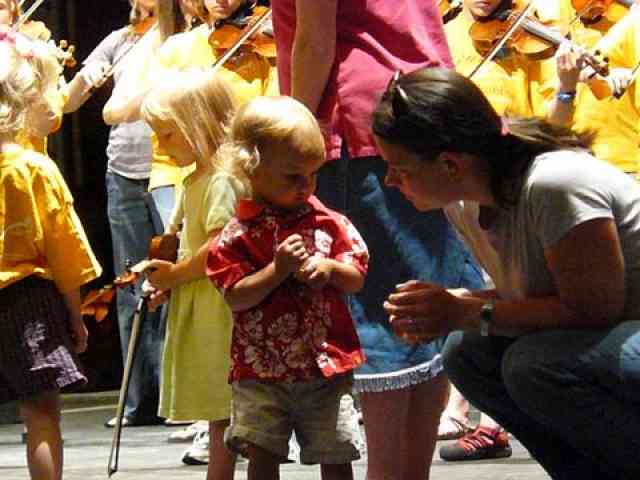
Photo by Suzuki in the Berkshires
Our lives are all so busy so it is easy fall prey to the temptation of skipping daily listening or daily practice or both. So think of what happens when we skip? Why do we need to be faithful to both?
Imagine trying to learn a foreign language without ever having heard it spoken. Now think how much easier it is with an “immersion” experience. When Suzuki devised his “mother tongue method,” he capitalized on the fact that learning the language of music works much the same way as learning any language.
So why listen to the recordings? Here are a few good reasons:
- First, listening to good quality music is enjoyable. It increases our musical sensitivity and this enjoyment motivates the listener to continue listening.
- It is so much easier to master the rhythms and use correct intonation (playing in tune) when the correct example is already stamped on the mind. This also enables self-correction as the learning takes place. Once imprinted, the music enters the subconscious mind and a “musical intuition” (brain- finger connection) forms.
- Listening actually allows the brain to experience the music before you play it. This is like “practicing for free” without doing the work! (However, this cannot substitute for the consistent daily practice!)
- Being able to hear or sing the piece in the mind makes learning easier. Listening gives us this ability. It is akin to visualizing a perfect golf swing or a well-executed tennis serves prior to playing. Research has shown this really works!
So help make your child’s learning easier. Play the work piece on endless repeat each morning. Also include the previous (“polish”) and subsequent (new) pieces. This music will remain playing in the brain all day. (How many of us have had an annoying radio or TV jingle play over and over in our mind wishing we “could turn it off?”) Also listen in the background other times during the day (as in the car), concluding at bedtime.
Need a reminder? Put a clothespin or a hair clip on your bathroom towel, toothbrush, or pajamas to remind you to turn on the music at bedtime. Stick a sticker on the light switch of your child’s room. Tie a “reminder ribbon” on the car steering wheel instead of around your finger. Use a twist tie on a kitchen cabinet, breakfast coffee or cereal box, or in the silverware drawer. You can have fun with this, too. Hide clues and have a daily “treasure hunt” or draw from a hat each day to see who turns the recording on and off. Have a family contest to see who comes up with the most creative suggestions. Also, those automatic timers (for turning on lights), which can be set to turn on and shut off at predetermined hours, work well.
Play the entire CD or tape on a regular basis as well. You can have fun with it, too. Try dancing the rhythms or “head, finger or feet dancing” or make up your own fun. Be creative!
You have chosen to give your child the gift of instrumental music. Imagine how much quicker and easier you’ll both enjoy this treasure as you listen each day.
You’ll make new discoveries each time you hear the music, and your child will be on the way to experiencing the joy of finer playing with ease, coupled, of course, with diligent daily practice. So, HAPPY LISTENING! Start now.









